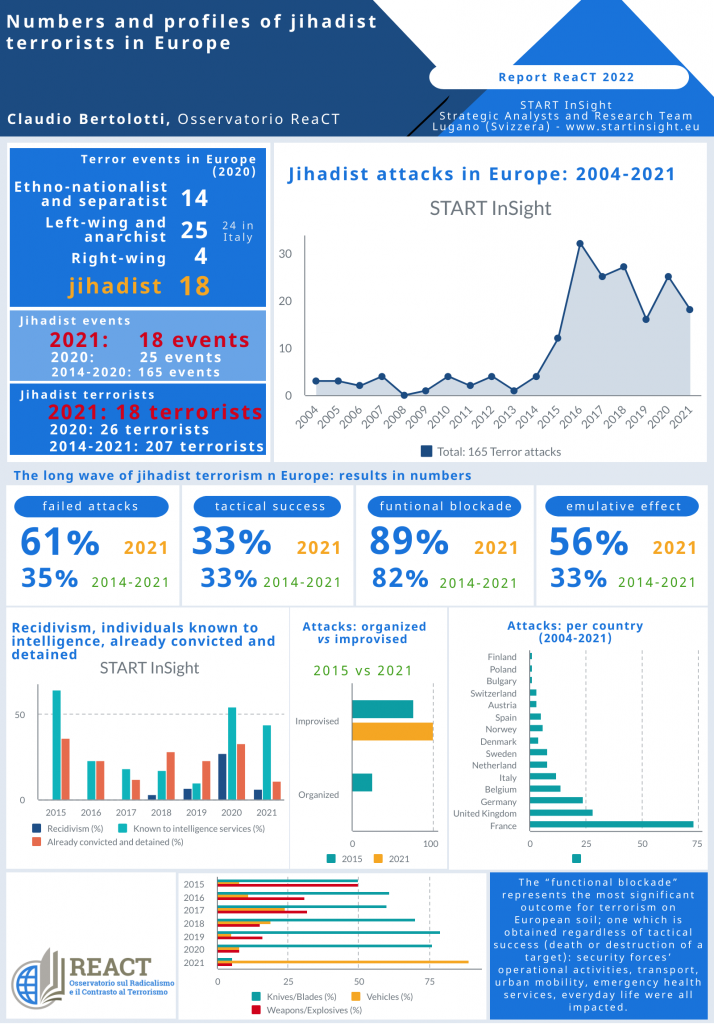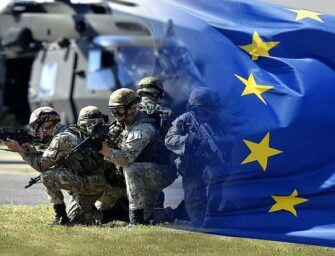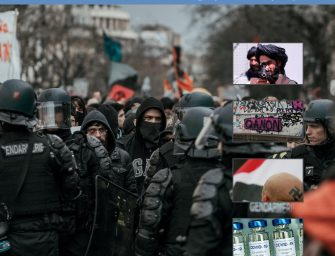New Insurrectional Terrorism ignites individual terrorism in Europe
by Claudio Bertolotti
From Africa to Afghanistan: Europe looks with concern at jihadist exaltation
The Islamic State no longer has the strength to dispatch terrorists to Europe as the loss of territory, financial strenght and recruits reduced its operational capability to zero. However, the threat remains significant due to the availability and action of lone actors, self-starters driven by emulation without a direct link to the organization.
While on the ideological level the Islamic State remains the main jihadist threat, it is however unlikely that it will be able to replicate the overwhelming appeal the “Caliphate” enjoyed in the 2014-2017 period, as it lost the advantage of novelty, which constituted its strength, particularly with younger people. In addition, both from a legislative and operational perspective, Europe has been able to significantly reduce its own vulnerabilities, although there were greater achievements in terms of counter-terrorism rather than prevention. On the whole, however, the scenario remains uncertain due to the risks connected to copycat attacks (“effetto emulativo” in Italian) and the “call to war” issued in relation to international events, which can mobilise individuals in the name of jihad. The most important event which occured in 2021 that has provided and will continue to provide impetus with respect to transnational jihad is the success of the Taliban in Afghanistan as, on the one hand, it feeds jihadist propaganda via the underlying message that “victory results from fighting to the bitter end”; on the other hand, it fuels a competition between jihadist groups engaged in exclusively local forms of struggle and resistance and those which, like the Islamic State, understand and promote jihad solely as an means of fighting to the bitter end on a global level.
In this overall and constantly evolving picture, we must pay attention to growing extremist forces in some areas of Africa, specifically in sub-Saharan Africa, the Sahel, the Horn of Africa and, furthermore, in Rwanda and Mozambique, in order to counter the rise of new “caliphates” or “wilayats” that could directly threaten Europe.
In its prolific jihadist propaganda, the Islamic State boasts of its spread throughout the African continent and emphasizes how the goal of countering the presence and spread of Christianity will lead the group to expand into other areas of the continent. In the Maghreb, Mashreq and Afghanistan, the activities of the Islamic State are centered around the intra-Muslim sectarian struggle, while in Africa its presence imposes itself as part of a conflict between Muslims and Christians with the help of propaganda insisting on the need to stop the conversion of Muslims to Christianity by “missionaries”, and under the “pretext” of humanitarian aid. Within this context, there’s no shortage of violence taking place; kidnappings and murders of religious missionaries, attacks against NGOs and international missions from Burkina Faso to Congo, and attacks on Christian villagers, especially during Christmas and New Year’s holidays.
A drop in attacks, but the threat of terrorism persists
Over the past three years, from a quantitative perspective, the frequency of terrorist attacks remained linear. From 2017 to 2020, 457 attacks took place in the European Union, the United Kingdom and Switzerland, including failed and foiled attacks: from 2014 to 2017, their number stood at 895.
In 2020, there were 119 attacks -including 62 in the UK and 2 in Switzerland-. According to Europol (TeSat 2020) 43% of those are attributed to radical left-wing movements (with a decrease from 26 to 25); 24% to separatist and ethno-nationalist groups; 7% to far-right groups (compared to 2019, there was an increase in percentage yet they decreased in absolute term); 26% are jihadist actions. Although jihadist violence is marginal compared to the total number of actions motivated by other ideologies, it remains the most relevant and dangerous in terms of results, the victims it causes -from 16 victims in 2020 to 13 in 2021- and direct effects.
In the wake of major terror events linked to the Islamic State group in Europe, 165 jihadist actions have taken place from 2014 to 2021, according to START InSight’s database; of those, 34 were explicitly claimed by the Islamic State; they were perpetrated by 219 terrorists (63 were killed in action); 434 victims lost their lives and 2,473 were injured.
The number of jihadist events recorded in 2021 stands at 18, down slightly from the 25 attacks of the previous year, but with an increase in the percentage of “emulative” actions – meaning, actions inspired by other attacks that occured over the previous days-; from 48% in 2020, they rose to 56% in 2021 (in 2019, they stood at 21%). 2021 also confirmed the predominance of individual, un-organized, mainly improvised and unsuccessful actions that progressively replaced the structured and coordinated actions which had characterized the European urban “battlefield” in the years from 2015 to 2017.

The “European” terrorists
Active terrorism is a male prerogative: out of 207 attackers, 97% are male (7 are women); unlike in 2020, when there were 3 female attackers, 2021 did not record the active participation of women.
The median age of the 207 terrorists (male and female) is 26: a figure which varies over time (from 24 years of age in 2016, to 30 in 2019). The biographical data of 169 individuals for whom we have complete information allow us to draw a very interesting picture which tells us that 10% are younger than 19, 36% are between 19 and 26, 39% are between 27 and 35 and, finally, 15% are older than 35.
88% of the attacks (where we have complete information) were carried out by second and third-generation “immigrants” and first-generation immigrants, both legal and irregular.
Of the 154 out of 207 terrorists analyzed through START InSight’s database, 45% are legal immigrants; 24% are descendants of immigrants (second or third generation); 19% are irregular immigrants; this last figure is growing, rising to 25% in 2020 and doubling to 50% in 2021. The presence of an 8% of citizens of European origin who have converted to Islam is significant. Overall, 77% of terrorists are regular residents of Europe, while the role of irregular immigrants stands out with a ratio of about 1 for every 6 terrorists. In 4% of the attacks, children/minors (7) were found to be among the attackers.
The ethno-national map of terrorism in Europe
The phenomenon of jihadist radicalization in Europe afflicts certain national/ethnic groups more than others. There is a proportional relationship between the main immigrant groups and terrorists, as it seems to appear from the nationality of the terrorists, or of the families of origin, which is in line with the size of foreign communities in Europe. The Maghrebi origins prevail: the ethno-national groups mainly affected by jihadist adherence are Moroccan (in France, Belgium, Spain and Italy) and Algerian (in France).
Increase in recidivism and individuals already known to intelligence
The role played by repeat offenders – individuals already convicted of terrorism who carry out violent actions at the end of their prison sentence and, in some cases, in prison – is prominent; they accounted for 3% of the terrorists in 2018 (1 case), then rose to 7% (2) in 2019, to 27% (6) in 2020, and were down to a single case in 2021. This seems to confirm the social danger represented by individuals who, in the face of a prison sentence, tend to postpone the conduct of terrorist actions; this evidence points to a potential increase in terrorist acts over the coming years, coinciding with the release of most terrorists currently detained.
Parallel to repeat offenders, START InSight found another significant trend, which is related to actions carried out by terrorists already known to European law enforcement or intelligence agencies: they account for 44% and 54% of the total in 2021 and 2020 respectively, compared to 10% in 2019 and 17% in 2018.
There is a certain stability related to participation in terrorist actions by individuals with a prison history (including those detained for non-terrorist offenses) with a figure of 23% in 2021, slightly down from the previous year (33% in 2020) but in line with 2019 (23% in 2019, 28% in 2018 and 12% in 2017); this confirms the hypothesis that sees prisons as places of radicalization.
Is the offensive capacity of terrorism being reduced?
In order to draw a precise picture of terrorism, one needs to analyse the three levels on which terrorism itself develops and operates, and that is the strategic, the operational and the tactical. Strategy consists in the employment of combat for the purpose of war; tactics is the employment of troops for the purpose of battle; the operational level is between these two. This is a simple summary which underlines an essential feature: that is, the employment of fighters.
Success at the strategic level is marginal
16% of the actions were successful at the strategic level, as they brought about structural consequences consisting in a blockade of national and/or international air/rail traffic, mobilization of the armed forces, far-reaching legislative interventions. This is a very high figure, in consideration of the limited organizational and financial capabilities of the groups and lone attackers. The trend over the years has been uneven, but it highlighted a progressive reduction in capability and effectiveness: 75% of strategic success was recorded in 2014, 42% in 2015, 17% in 2016, 28% in 2017, 4% in 2018, 5% in 2019, 12% in 2020 and 6% in 2021. Overall, attacks garnered international media attention 79% of the time, 95% domestically, while organized and structured commando and team-raid actions received full media attention. An evident, as much as sought after, media success that may have significantly affected the recruitment campaign of aspiring martyrs or jihad fighters, whose numerical magnitude remains high in correspondence with periods of heightened terrorist activity (2016-2017).But while it is true that mass media amplification has positive effects on recruitment, it is also true that this attention tends to diminish over time, due to two main reasons: the first, is the prevalence of low-intensity actions over high-intensity actions – which have been decreasing – and on low- and medium-intensity actions – which increased significantly from 2017 to 2021. The second, is that public opinion is increasingly inured to terroristic violence and consequently less ‘touched’, particularly by “low” and “medium intensity” events.
The tactical level is worrisome, but it is not the priority of terrorism
Assuming that the aim of terrorist attacks consists in killing at least one enemy (in 35% of the cases, the targets are security forces), this aim has been achieved over the period from 2004 to 2021 on average in 50% of the cases. However, it should be taken into account that the large time frame tends to affect the margin of error; the trend over the 2014-2021 period, hints at a decline in the results of terrorism, with a prevalence of low-intensity attacks and an increase in actions with a failed outcome at least until 2019. The results of the last six years in particular, show that success at a tactical level was obtained, in 2016, in 31% of the cases (against 6% of formally unsuccessful acts), while 2017 recorded a success rate of 40% and a failure rate of 20%. An overall trend that, when taking into consideration a 33% success rate at the tactical level, a doubling of failed attacks (42%) in 2018 and a further downward figure of 25% success rate in 2019, can be read as a result of the progressive decrease in the operational capability of terrorists and the increased reactivity of European security forces. But if the analysis suggests a technical capability that has indeed been reduced, it is also true that the improvised and unpredictable character of the new individual and emulative terrorism has led to an increase in successful actions, growing from 32% in 2020 to 44% in 2021.
The real success is at operational level. The “functional blockade”
Even when it fails, terrorism gains, in terms of the costs inflicted upon its target: e.g. by engaging the armed forces and Police in an extraordinary way, distracting them from normal routine activities and/or preventing them from intervening in support of the community; by interrupting or overloading the health services; by limiting, slowing down, diverting or stopping collective urban, air and naval mobility; by restricting the regular course of daily personal, commercial and professional activities, to the detriment of affected communities and, moreover, by significantly reducing the technological advantage, the operational potential and resilience; and finally, more in general, by inflicting direct and indirect damage, regardless of the ability to cause casualties. Consistently, the limitation in the freedom of citizens is a measurable result that terrorism obtains through its actions.
In other words, terrorism is successful even in the absence of victims, as it can still impose economic and social costs on the community and influence the latter’s behaviour over time as a consequence of new security measures aimed at safeguarding the community: this effect is what we call the “functional blockade”.
The ever-decreasing operational capability of terrorism notwithstanding, the “functional blockade” continues to be the most significant result obtained by terrorists, regardless of tactical success (killing of at least one target). While tactical success has been observed in 34% of the attacks which took place since 2004, terrorism has proven its effectiveness by inducing a “functional blockade” in an average of 82% of the cases, with a peak of 92% in 2020 and 89% in 2021: an impressive result, when considering the limited resources deployed by terrorists. The cost-benefit ratio is, no doubt, in favour of terrorism.












































There are no comments
Add yours